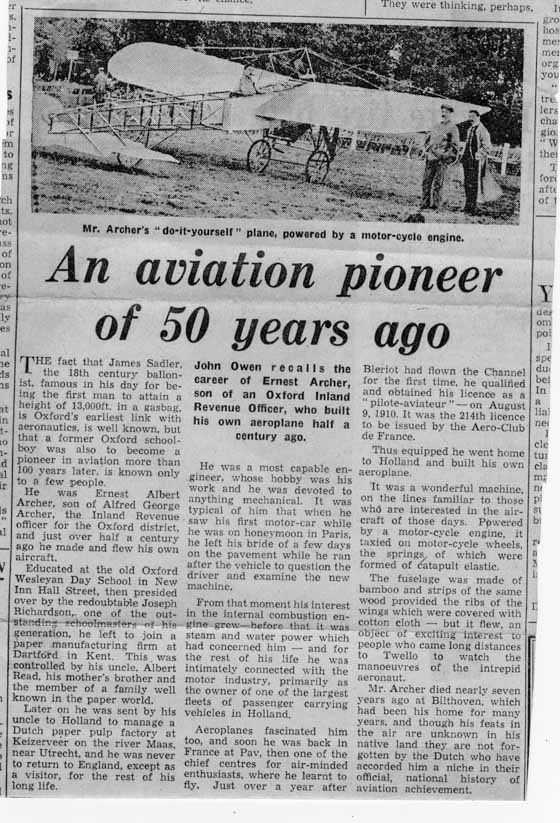
This Oxford Mail article is all reasonably true (albeit perhaps with a little journalitisic licence) apart from the three paragraphs before the final paragraph.
What Ernest Archer actually did was to fly a Type XI Bleriot monoplane (manufactured in the Bleriot factory for the Dutch national aviation body), at, inter alia, Twello, Holland. Sustaining a crash-landing at a fairly early date, his aviation career came to a somewhat premature end. But his achieements at these early dates are by no means insignificant. (28.3.2018). He had been appointed as an official pilot for the Dutch aviation body, and had trained at the Bleriot flying school in France, gaining his (French) aviation licence. Bleriot himself had flown the Channel in 1909 in his own-designed 'Bleriot Type XI' aircraft, thereby winning the prize money offered by one of the British newspapers to the person first to achieve this significant feat. (30.3.18)
Far from himself designing the aircraft he flew, my great-uncle Ernest had, as far as I can tell, no design input to it at all, and it did not use a motor-cycle engine nor motor-cycle wheels nor 'catapult elastic' for the suspension, as the Oxford Mail article states. The design of a Bleriot Type XI is extremely well-known and recorded, and I may get round to looking up those details to record them here. (30.3.18).
This is not to denigrate one iota Great Uncle Ernest's undoubted achievements, in doing what he actually did. If my 1962 stab at the date of this article is correct, it suggests to me that the Oxford Mail talked to Ernest Archer's brother William George Reed Archer, aka WGRA, who lived until 1969, aboiut the technical side (indeed the entire content of the article) of 'Ernie's aviation' as grandpa may well have called it. I have several articles (published in this website) done by them after interviewing WGRA. And indeed he may well have initiated this article about his then dead elder brother.
And the total absence of any knowledge (on WGRA's part) about the Dutch Aviatiion Authority's involvement, and that Ernie was (one of) their appointed pilots, and that the aircraft he flew was theirs, made at the Bleriot factory in France, and that it was that purchase of an aircraft, which funded Ernest's flying tuition at The Bleriot School, as an already-appointed pilot, tells us a lot.
Of course WGRA may have forgotten those details by 1962, but he hadn't forgotten all the early details of Ernie's life, which ring true to me. So I think it must have been the case that, perhaps, EEA didn't tell his younger brother exactly the basis of what he ws doing in Holland. They had both gone there to work at their mother's brother Ernest Albert Reed's paper factory at Raamsdonksveer. Quite adventurous in itself. Ernest went first, then William. Ernest married a local Dutch girl and stayed. William didn't and came back to Oxford in 1900, and married an Oxford girl. Evidently neither got on particularly well at 'Uncle Ernest' (Reed)'s paper mill. Perhaps the flying venture was Ernest's next after paper-making. If so, he stuck at that quite a long time. I believe I found the answer to that in my 'Dutch' online research. (2.4.18)
Here is an answer from the text below the photo of another item in this photoalbum:
Translated into English:
On the 3rd of October, 1902, the Englishman E.A. (Ernest) Archer, a resident of Helmond, purchased an automobile from H.A. Tasche, a Nijmegen salesman of automobiles and bicycles. Most likely, this was Carel van Rosendael's Swallow (for which see the relevant entry). Ernest Archer was later employed by R.S. Stokvis and would yet play a role in early Dutch aviation in 1910, by giving demonstration flights and flying lessons in a Blériot XI.
Mid-december 1913, as an importer of Morris automobiles, he was present at the 11th RAI exhibition 'of small automobiles, motorized bicycles, etc.' that was held at the Palace of the People's Industry at Amsterdam. In the annex of the glass palace at Frederik's Square he had constructed a small Morris stand, where two vehicles could be seen: a 1914 deluxe version of the Morris Oxford type, as well as the traditional standard issue of said type.
So it is fairly clear that Ernie Archer was doing his flying at the same time as beginning his main career of car-salesman and Morris-car-importer into Holland. (2.4.18).